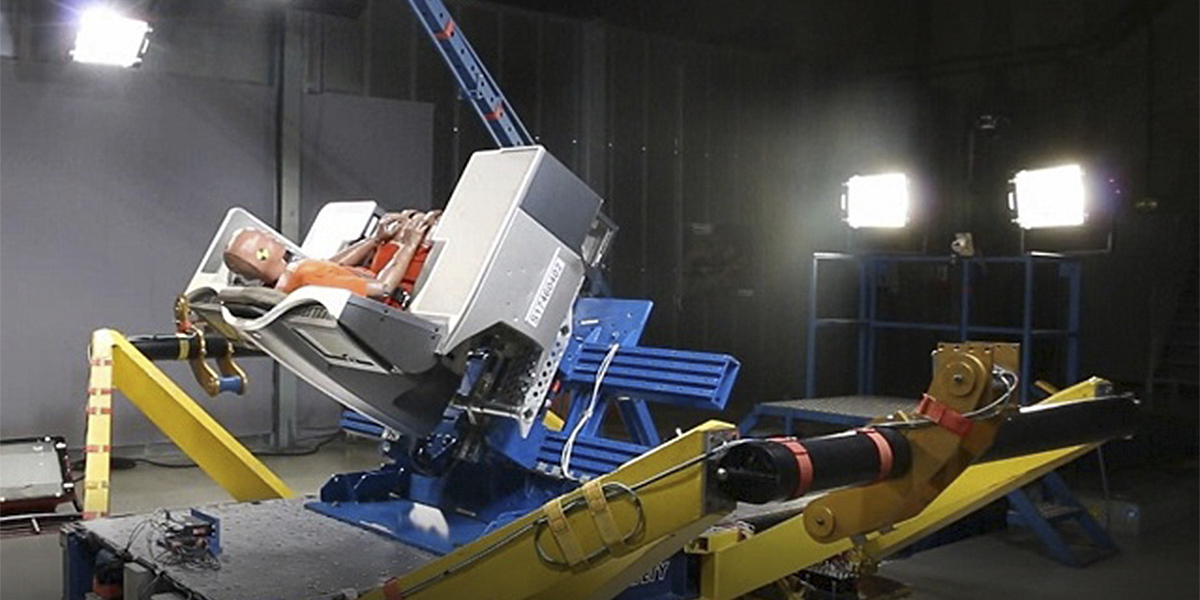ASTM D3574 Foam Cushion Crash Energy Absorption Testing
The ASTM D3574 foam cushion crash energy absorption test is a critical procedure used to evaluate the performance of protective structures designed for occupant safety in automotive applications. This test method measures the ability of a foam cushion to absorb and dissipate impact energy during simulated collision events. The results provide vital information about the effectiveness of these cushions in real-world scenarios, ensuring that they meet the necessary standards for passenger protection.
The ASTM D3574 test is particularly important because it helps manufacturers understand how their designs will perform under various crash conditions. By using this standard, companies can ensure that their products not only comply with regulatory requirements but also offer superior performance beyond mere compliance levels. This approach allows for continuous improvement in passive safety systems by identifying areas where enhancements could be made to better protect vehicle occupants.
The test involves placing a foam cushion specimen between two rigid surfaces and subjecting it to an impact from one of the surfaces, typically with controlled speed and force parameters specified according to ASTM D3574. The goal is to measure how well the foam absorbs energy during this event while minimizing any residual deformation that might affect the integrity of the structure or pose a risk to occupants.
One key aspect of ASTM D3574 testing is specimen preparation, which includes selecting appropriate materials and dimensions for the cushion based on expected loadings and crash scenarios. Proper sample conditioning is also crucial; this may involve preconditioning samples at specific temperatures or humidities to ensure consistent mechanical properties throughout testing.
The instrumentation used in ASTM D3574 foam cushion crash energy absorption tests includes specialized loading machines capable of applying controlled impacts along with sensors that monitor displacement, force, and acceleration during the test sequence. Data collected from these instruments allows analysts to calculate absorbed energies and compare them against specified thresholds outlined in ASTM D3574.
Another critical component of this testing procedure is determining whether the foam cushion meets all applicable acceptance criteria established by ASTM D3574. These criteria consider factors such as maximum allowable deformation, energy absorption efficiency, and post-impact structural integrity among others. Compliance with these standards ensures that the tested materials are safe and effective for use in automotive applications.
Real-world applications of ASTM D3574 foam cushion crash energy absorption testing extend far beyond just laboratory settings; they play an essential role in product development cycles where iterative improvements can be made based on feedback from this type of evaluation. As part of broader quality assurance programs, these tests contribute significantly towards maintaining high standards across industries involved in automotive manufacturing.
- Customer Impact and Satisfaction: Understanding the performance metrics provided by ASTM D3574 testing helps improve overall product safety, which enhances customer trust and satisfaction. By ensuring that vehicles meet or exceed regulatory requirements through rigorous testing procedures like those specified in ASTM D3574, manufacturers can provide safer cars for consumers.
Benefits
The benefits of conducting ASTM D3574 foam cushion crash energy absorption tests go beyond mere compliance with industry standards; they encompass numerous advantages that contribute to enhanced product quality and customer satisfaction. Firstly, by adhering strictly to the procedures outlined in ASTM D3574, manufacturers gain valuable insights into how their designs will perform under realistic crash conditions, allowing for more informed decisions during product development.
Secondly, meeting these stringent criteria demonstrates a commitment to excellence that resonates positively with both regulatory bodies and end-users alike. Consumers appreciate knowing that the vehicles they purchase have been subjected to thorough testing designed specifically to safeguard them in case of accidents. This perception fosters loyalty and enhances brand reputation.
Thirdly, compliance with ASTM D3574 ensures long-term reliability by identifying potential weaknesses early on so that necessary adjustments can be made before products reach market shelves. Such proactive measures help prevent costly recalls later down the line while maintaining a high level of trust between manufacturers and consumers.
In summary, incorporating ASTM D3574 foam cushion crash energy absorption testing into your quality assurance program offers tangible benefits such as improved product safety, increased customer satisfaction, enhanced brand reputation, and reduced risk associated with unforeseen issues arising from subpar materials or design flaws.





